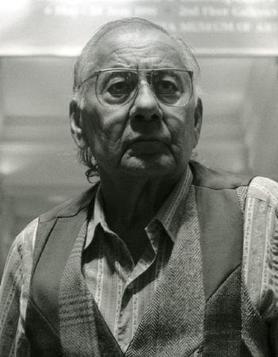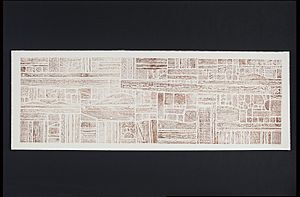George Morrison (artist) facts for kids
Quick facts for kids
George Morrison
|
|
|---|---|
 |
|
| Born | September 30, 1919 |
| Died | April 17, 2000 (aged 80) Red Rock, near Grand Marais, Minnesota
|
| Nationality | Grand Portage Band Minnesota Chippewa Tribe |
| Occupation | Abstract Expressionist Painter and Sculptor |
| Spouse(s) |
|
| Children | Briand Mesaba |
George Morrison (born September 30, 1919 – died April 17, 2000) was an amazing Ojibwe artist from Minnesota. He was known for his beautiful landscape paintings and cool sculptures. His Ojibwe name was Wah Wah Teh Go Nay Ga Bo, which means "Standing In the Northern Lights."
George Morrison was part of a group of artists who wanted to create their own unique style. He became famous for his wood collage sculptures and his favorite type of art: landscape paintings.
Contents
Discovering George Morrison's Art Journey
Early Life and Learning
George Morrison was a member of the Grand Portage Band of the Minnesota Chippewa Tribe. He was born in 1919 in Chippewa City, near the Grand Portage Indian Reservation.
George grew up in a big family with 12 children. His father was a trapper and could speak the Ojibwe language very well. When George was a child, he had surgery and had to wear a full body cast for months. This was when he started to draw and discover his artistic talent!
He went to a Native American boarding school in Wisconsin for a short time. Because of his health, George returned to Minnesota. He attended a Native American sanatorium and a hospital for children. He finished high school in 1938 and then studied art at the Minnesota School of Art (now called the Minneapolis College of Art and Design). He graduated in 1943.
George won a special scholarship called the Ethel Morrison Van Derlip Traveling Scholarship. This allowed him to study art in New York City at the Art Students League from 1943 to 1946. There, he met other artists who created abstract expressionist art. He also learned about different art styles like cubism and surrealism.
In 1947, George started teaching at the Cape Ann Art School. The next summer, he and another artist took over the school and renamed it the Rockport Art School. George met his first wife, Ada Reed, in Provincetown, Massachusetts. They got married in 1948.
In 1952, George received a Fulbright scholarship. This allowed him to study art in Paris and Antibes, France. He also studied at the University of Aix-Marseilles. In 1953, he received another award and moved to Duluth, Minnesota.
Later Career and Teaching
George lived in Duluth, Minnesota for several years before moving back to New York City in 1954. There, he met famous American artists like Willem de Kooning and Jackson Pollock. He then taught art at many different schools, including places in Minneapolis, Duluth, Dayton, Ohio, Ithaca (at Cornell University), Pennsylvania (at Penn State), and New York City. While teaching in Dayton, George met his second wife, Hazel Belvo.
From 1963 to 1970, George taught at the Rhode Island School of Design.
In 1968, George won a big award at an art exhibition in Washington, D.C.. In 1969, he received an honorary Master of Fine Arts degree from the Minneapolis College of Art and Design.
Starting in 1970, he taught American Indian studies and art at the University of Minnesota. He retired in 1983. In the mid-1970s, George and his wife bought land near Grand Portage, Minnesota on Lake Superior. They called this special place Red Rock, and it became their home and art studio. George faced some serious illnesses but kept creating art until he passed away at Red Rock in April 2000.
In 1999, George Morrison was honored as a Master Artist by the Eiteljorg Fellowship for Native American Fine Art.
George Morrison's Lasting Impact
In 2022, George Morrison's amazing artwork was honored by the United States Postal Service. They released a series of postage stamps that featured five of his paintings! This shows how important his art is.
Exploring George Morrison's Art Style
George Morrison learned how to paint realistic pictures when he was at the Minneapolis School of Art. But when he studied in New York City, his art became more modern and abstract. This means his art didn't always look exactly like real life.
George said that many things influenced his art. These included art styles like cubism, surrealism, and abstract expressionism. In his drawings and paintings, he used abstract shapes to show natural things. He often used landscapes and mosaic patterns in his paintings. For his cool wood collages, George would collect driftwood from shorelines. He would then carefully arrange and glue these pieces onto a board to create unique art.
Besides European and North American art styles, George Morrison was also inspired by ancient art from Central and South America, and art from Australian Aboriginal people.
George Morrison's work was part of a big art show called Stretching the Canvas: Eight Decades of Native Painting. This show was held at the National Museum of the American Indian George Gustav Heye Center in New York from 2019 to 2021.
A large granite artwork by Morrison, called "Tableau – A Native American Mosaic," has been moved several times in downtown Minneapolis. It shows how important and loved his public art is!
The United States Postal Service released five of George Morrison's paintings on Forever Stamps on April 22, 2022. Some of the paintings featured on these stamps include Sun and River (1949), Phenomena Against the Crimson: Lake Superior Landscape (1985), and Spirit Path, New Day, Red Rock Variation: Lake Superior Landscape (1990).
Selected Art Shows and Exhibitions
George Morrison's art was shown in many places! Here are some of the solo exhibitions where people could see his work:
- 1948–1960: Grand Central Moderns Gallery - New York City
- 1949: Hart Gallery - Duluth, Minnesota
- 1950: Ed Weiner Gallery - Provincetown, Massachusetts
- 1954: University of Minnesota - Duluth, MN
- 1960: Dayton Art Institute - Dayton, Ohio
- 1962: Cornell University - Ithaca, New York
- 1973–1974: George Morrison: Drawings, a traveling show that went to the Walker Art Center in Minneapolis, the Heard Museum in Phoenix, and other cities.
- 1976: Minneapolis Institute of Arts - Minneapolis, MN
- 1987–1988: "Horizon: Small Painting Series 1980-87," Minnesota Museum of American Art - St. Paul, MN
- 1990: "Standing in the Northern Lights: George Morrison, A retrospective," a big show that traveled to the Tweed Museum of Art in Duluth and the Minnesota Museum of Art in St Paul.
- 2013–2014: Modern Spirit: The Art of George Morrison, another traveling show that visited the Plains Art Museum, the National Museum of the American Indian, and the Minnesota History Center.


